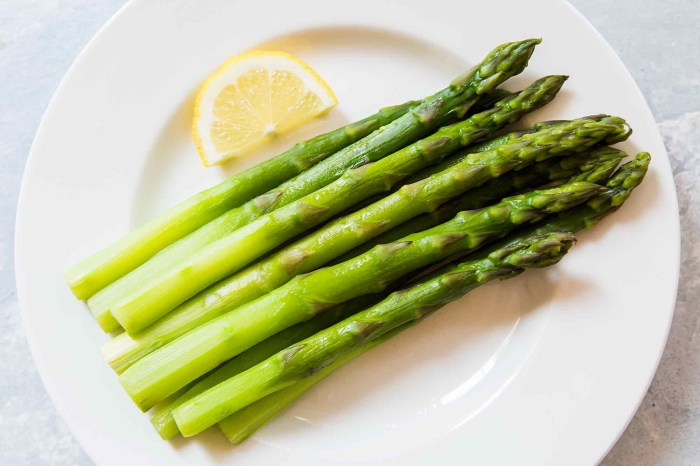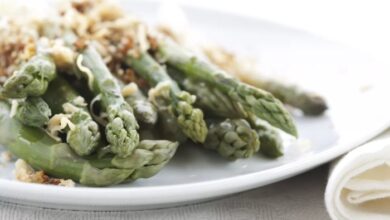
The Best Steamed Asparagus: A Guide to Flavor and Perfection
The best steamed asparagus isn’t just about a healthy side dish; it’s a symphony of flavors and textures that can elevate any meal. From choosing the right variety to mastering the art of steaming, there’s a world of knowledge to uncover.
Get ready to explore the secrets of perfect asparagus, from farm to table.
This guide will take you on a journey, from selecting the ideal asparagus spears to creating flavor combinations that will tantalize your taste buds. We’ll delve into the different varieties, preparation techniques, and steaming methods, ultimately guiding you to create the most delicious steamed asparagus you’ve ever tasted.
The Best Asparagus Varieties

Asparagus is a delicious and nutritious spring vegetable that comes in a variety of types. While the most common is green asparagus, there are also purple and white varieties. Each type has unique characteristics, including flavor, texture, and cooking time.
Understanding these differences can help you choose the best asparagus for your needs.
Types of Asparagus
Asparagus varieties differ in their flavor, texture, and cooking time. Here are some of the most popular varieties:
- Green Goliath:This variety is known for its thick, green spears that are juicy and flavorful. It has a mild, sweet taste and a tender texture. Green Goliath asparagus is a good choice for steaming, roasting, or grilling.
- Purple Passion:This variety is named for its beautiful purple spears, which turn green when cooked. Purple Passion asparagus has a slightly sweeter flavor than green asparagus and a slightly firmer texture. It’s a good choice for steaming or grilling.
- Jersey Giant:This variety is known for its large, thick spears. It has a slightly more assertive flavor than other varieties and a slightly tougher texture. Jersey Giant asparagus is a good choice for roasting or grilling.
Best Asparagus Varieties for Steaming
When choosing asparagus for steaming, consider varieties that are tender and retain their flavor well. The best asparagus varieties for steaming are those that have a thin, delicate texture. Some popular choices include:
- Green Goliath:This variety is known for its tender spears that are perfect for steaming. It retains its flavor well and has a mild, sweet taste.
- Purple Passion:This variety is also a good choice for steaming. It has a slightly firmer texture than Green Goliath but still cooks quickly and retains its flavor well.
Choosing the Best Asparagus
When choosing asparagus, look for spears that are firm and straight. Avoid spears that are limp or have broken tips. The spears should also be a consistent color and free of blemishes.
“Asparagus should be cooked quickly to preserve its flavor and nutrients.”
There’s something so simple and satisfying about perfectly steamed asparagus, the tender stalks glistening with a touch of butter. But sometimes, I crave something a little more adventurous, like these amazing grilled hearts of romaine that are bursting with smoky flavor.
Then again, nothing beats the classic simplicity of steamed asparagus, especially when paired with a squeeze of lemon and a sprinkle of flaky salt.
Preparing Asparagus for Steaming
Asparagus is a delicious and nutritious vegetable that is easy to prepare for steaming. Steaming asparagus preserves its vibrant green color and delicate flavor, making it a popular cooking method. Before steaming, it is essential to prepare the asparagus properly by trimming, washing, and peeling.
This process ensures that the asparagus cooks evenly and retains its freshness.
Trimming Asparagus Spears
Trimming the tough ends of asparagus spears is crucial for a pleasant eating experience. These ends are woody and fibrous, making them unpleasant to chew. To trim the asparagus, locate the point where the spear starts to become tough and woody.
This is usually about an inch or two from the bottom. You can snap the end off by bending the spear until it breaks. Alternatively, you can use a sharp knife to cut the tough end off.
Washing Asparagus Spears
After trimming, it is important to wash the asparagus spears thoroughly. This removes any dirt, debris, or pesticides that may be present. You can wash the asparagus under cold running water, making sure to gently scrub the spears with your fingers or a vegetable brush.
There’s nothing quite like the simple elegance of perfectly steamed asparagus. The tender stalks, lightly seasoned with salt and pepper, are a perfect side dish for any meal. But if you’re looking for a more substantial breakfast option, why not try a overnight corn flake bake ?
It’s a sweet and comforting way to start your day, and pairs beautifully with the crispness of steamed asparagus. After all, a balanced meal is a happy meal, and a happy meal is the best way to start your day.
Ensure all the spears are rinsed thoroughly, and any remaining dirt or debris is removed.
Peeling Asparagus Spears
Peeling asparagus is optional but can enhance its flavor and texture. It is especially beneficial for thicker asparagus spears. Use a vegetable peeler to remove the tough outer layer of the spear, starting from the bottom and working your way up.
Peeling helps to soften the asparagus and allows for more even cooking.
The best steamed asparagus is crisp-tender, bright green, and bursting with flavor. It’s a perfect side dish for any meal, especially when paired with something hearty and comforting like a bowl of chicken mushroom and rice soup. The creamy broth and earthy mushrooms complement the delicate asparagus beautifully, creating a satisfying and well-balanced meal.
Steaming Methods and Techniques
Steaming asparagus is a simple and effective cooking method that preserves its vibrant green color, delicate texture, and fresh flavor. There are several methods you can use to steam asparagus, each with its own advantages and disadvantages. This guide will help you choose the best method for your needs and achieve perfectly cooked asparagus.
Steaming Methods, The best steamed asparagus
The most common methods for steaming asparagus are using a steamer basket, a pot with a lid, and a microwave steamer. Each method has its own advantages and disadvantages, and the best choice depends on your preferences and equipment.
Using a Steamer Basket
A steamer basket is a versatile tool that can be used to steam various vegetables, including asparagus. It’s a great option for cooking asparagus because it allows for even heat distribution and prevents the asparagus from becoming soggy.
- Advantages:
- Even heat distribution for consistent cooking.
- Prevents asparagus from becoming soggy.
- Easy to clean.
- Disadvantages:
- Requires a separate pot for boiling water.
- Can be bulky to store.
Using a Pot with a Lid
A pot with a lid is another simple and effective way to steam asparagus. It’s a great option if you don’t have a steamer basket or prefer a less-bulky method.
- Advantages:
- Requires minimal equipment.
- Easy to clean.
- Disadvantages:
- May not provide as even heat distribution as a steamer basket.
- Can be difficult to monitor the cooking process.
Using a Microwave Steamer
A microwave steamer is a convenient option for quickly steaming asparagus. It’s a good choice if you’re short on time or don’t have a stovetop available.
- Advantages:
- Fast cooking time.
- Convenient for small quantities.
- Disadvantages:
- May not provide as even heat distribution as other methods.
- Limited capacity.
Steaming Asparagus: Step-by-Step Guide
This step-by-step guide uses a steamer basket, but you can adapt it for other methods.
Step 1: Prepare the Asparagus
- Trim the woody ends of the asparagus spears. You can snap them off by bending the spear until it breaks naturally.
- Wash the asparagus spears thoroughly under cold running water.
Step 2: Fill the Pot with Water
- Fill a pot with about an inch of water. The water level should be below the bottom of the steamer basket.
- Bring the water to a rolling boil over high heat.
Step 3: Place the Asparagus in the Steamer Basket
- Arrange the asparagus spears in a single layer in the steamer basket, making sure they are not overcrowded.
- Place the steamer basket over the boiling water, ensuring it fits securely.
Step 4: Steam the Asparagus
- Cover the pot with a lid and steam the asparagus for 3-5 minutes, or until tender-crisp. The exact cooking time will depend on the thickness of the spears.
- To check for doneness, pierce a spear with a fork. It should be tender but still slightly firm.
Step 5: Serve
- Remove the steamer basket from the pot and transfer the asparagus to a serving dish.
- Season with salt, pepper, and any other desired seasonings.
- Serve immediately.
Tip:For extra flavor, add a few drops of lemon juice or a pinch of herbs to the boiling water before steaming the asparagus.
Seasoning and Flavor Combinations
The simplest way to enhance the flavor of steamed asparagus is with a sprinkle of salt and pepper. But there are endless possibilities for seasoning and flavor combinations that can elevate this classic vegetable to new heights. Let’s explore some classic and innovative seasoning ideas, as well as how to pair asparagus with different flavor profiles.
Classic Seasonings
Classic seasonings for steamed asparagus often focus on enhancing the natural sweetness and earthy notes of the vegetable.
- Salt and Pepper:A simple yet effective way to bring out the natural flavors of asparagus.
- Lemon Juice:Adds a bright, citrusy note that complements the delicate flavor of asparagus.
- Butter:A rich and creamy addition that adds a luxurious touch to steamed asparagus.
- Olive Oil:A healthy and flavorful option that enhances the asparagus’s natural flavors.
- Garlic:A pungent and aromatic addition that pairs well with the earthy notes of asparagus.
- Fresh Herbs:Fresh herbs like dill, parsley, chives, or tarragon can add a burst of freshness and complexity to the flavor profile.
Innovative Seasonings
For a more adventurous approach, consider incorporating these innovative seasonings into your steamed asparagus:
- Chili Flakes:A touch of heat can add a surprising dimension to the flavor of asparagus.
- Nutmeg:A warm and slightly sweet spice that complements the earthy notes of asparagus.
- Sesame Seeds:Toasted sesame seeds add a nutty and savory flavor to steamed asparagus.
- Ginger:A pungent and spicy flavor that adds a unique twist to asparagus.
- Soy Sauce:A savory and salty addition that can add depth to the flavor of asparagus.
- Citrus Zest:Zest from lemons, oranges, or grapefruits adds a bright and refreshing citrus note to asparagus.
Flavor Profile Pairings
Asparagus is a versatile vegetable that can be paired with a variety of flavor profiles. Here are some popular combinations:
| Seasoning Combination | Flavor Profile |
|---|---|
| Lemon Juice, Olive Oil, and Fresh Dill | Bright and Citrusy |
| Butter, Garlic, and Parmesan Cheese | Rich and Savory |
| Soy Sauce, Sesame Seeds, and Chili Flakes | Asian-Inspired and Spicy |
| Ginger, Honey, and Lime Juice | Sweet and Spicy |
| Nutmeg, Brown Butter, and Toasted Almonds | Earthy and Nutty |
Serving and Presentation

Steamed asparagus, with its vibrant green hue and delicate texture, offers a blank canvas for culinary creativity. Its versatility allows it to be served in a variety of ways, from simple side dishes to elegant main courses. Mastering the art of presentation elevates this humble vegetable to a culinary masterpiece.
Presentation Techniques
The visual appeal of a dish plays a significant role in its overall enjoyment. A well-presented plate of steamed asparagus can transform a simple meal into a culinary experience. Here are some techniques to elevate the presentation of your steamed asparagus:
- Fanning: Arrange the asparagus spears in a fan shape, with the tips pointing outwards. This creates a visually appealing and elegant presentation.
- Stacking: Stack the asparagus spears vertically, creating a modern and minimalist look. This technique is particularly effective when serving asparagus as a side dish.
- Layering: Layer the asparagus spears with other ingredients, such as roasted vegetables, grilled chicken, or fresh herbs. This creates a visually appealing and flavorful dish.
- Color Contrast: Utilize the natural green color of asparagus to create contrast with other ingredients. For instance, pairing it with red tomatoes or orange peppers can add vibrancy to the plate.
Table Setting
A well-thought-out table setting can enhance the dining experience. When featuring steamed asparagus as the centerpiece, consider the following:
- Color Palette: Choose a color scheme that complements the green hue of the asparagus. White, cream, or beige linens provide a neutral backdrop, while pops of color can be introduced through napkins, placemats, or centerpieces.
- Centerpiece: A simple arrangement of fresh flowers or a bowl of colorful fruits can add a touch of elegance to the table. Choose flowers or fruits that complement the asparagus in color and texture.
- Dinnerware: Select dinnerware that enhances the presentation of the asparagus. White or cream-colored plates provide a clean and classic look, while patterned plates can add a touch of personality.
Asparagus Nutrition and Health Benefits: The Best Steamed Asparagus
Asparagus is a nutritional powerhouse, packed with vitamins, minerals, and antioxidants. Its unique flavor and versatility make it a delicious addition to any meal, but its health benefits are equally impressive.
Nutritional Content of Asparagus
Asparagus is an excellent source of essential nutrients, including vitamins, minerals, and antioxidants.
- Vitamins:Asparagus is particularly rich in vitamin K, which is crucial for blood clotting and bone health. It also contains folate, essential for cell growth and development, and vitamins A, C, and E, which contribute to overall health and well-being.
- Minerals:Asparagus is a good source of minerals like potassium, which helps regulate blood pressure, and magnesium, important for muscle function and energy production. It also contains copper, manganese, and phosphorus.
- Antioxidants:Asparagus is packed with antioxidants, such as glutathione, which protects cells from damage caused by free radicals. It also contains flavonoids, which have anti-inflammatory and anti-cancer properties.
Health Benefits of Asparagus
The nutrient-rich composition of asparagus contributes to a wide range of health benefits.
- Supports Heart Health:Asparagus’s high potassium content helps regulate blood pressure, reducing the risk of heart disease. Its fiber content also helps lower cholesterol levels.
- Promotes Digestive Health:The fiber in asparagus promotes regular bowel movements and aids in digestion. It can also help prevent constipation and other digestive issues.
- Enhances Immune Function:The vitamin C and antioxidants in asparagus boost the immune system, helping the body fight off infections and illnesses.
- May Reduce Cancer Risk:Studies suggest that asparagus’s antioxidants and other compounds may have anti-cancer properties, potentially reducing the risk of certain types of cancer.
- Supports Bone Health:Asparagus is a good source of vitamin K, which plays a crucial role in bone health. It also contains calcium, another essential mineral for strong bones.
Nutritional Value of Asparagus
Here’s a table showcasing the nutritional value of 100 grams of cooked asparagus:
| Nutrient | Amount |
|---|---|
| Calories | 20 |
| Protein | 2 grams |
| Carbohydrates | 3 grams |
| Fiber | 2 grams |
| Vitamin K | 48 mcg (53% DV) |
| Folate | 63 mcg (16% DV) |
| Vitamin C | 9 mg (10% DV) |
| Potassium | 230 mg (7% DV) |
| Magnesium | 15 mg (4% DV) |
DV: Daily Value






